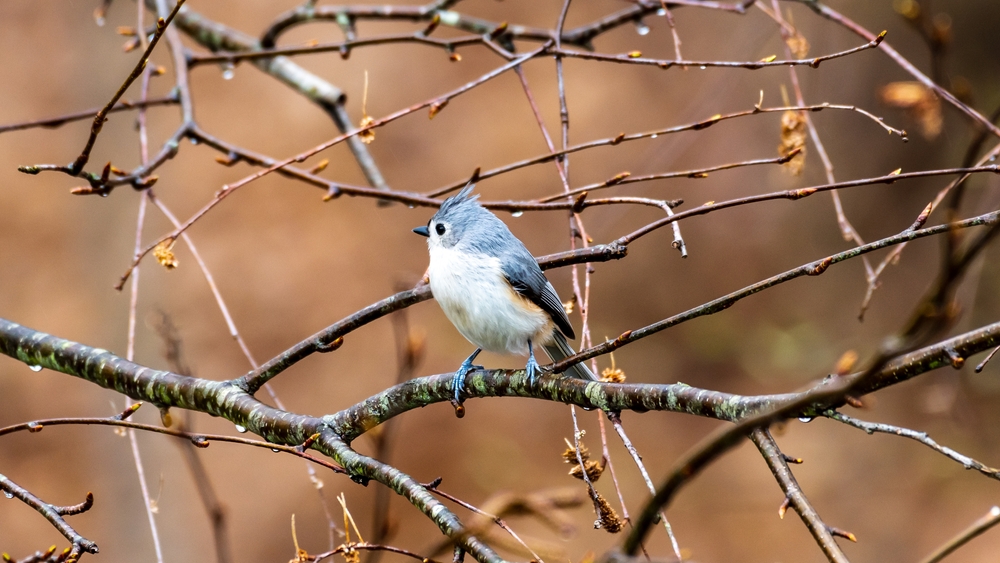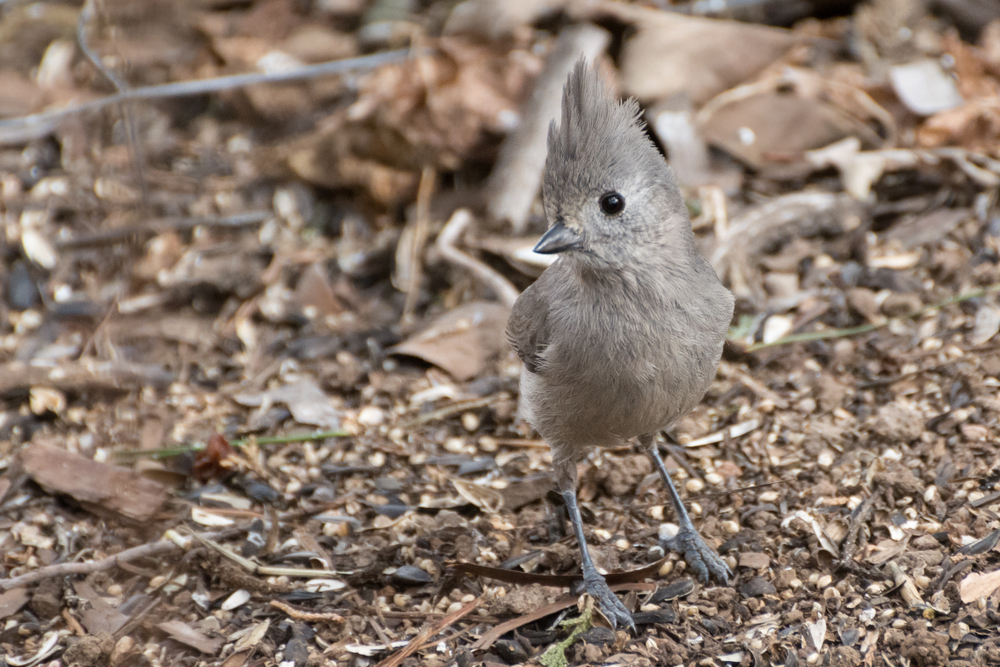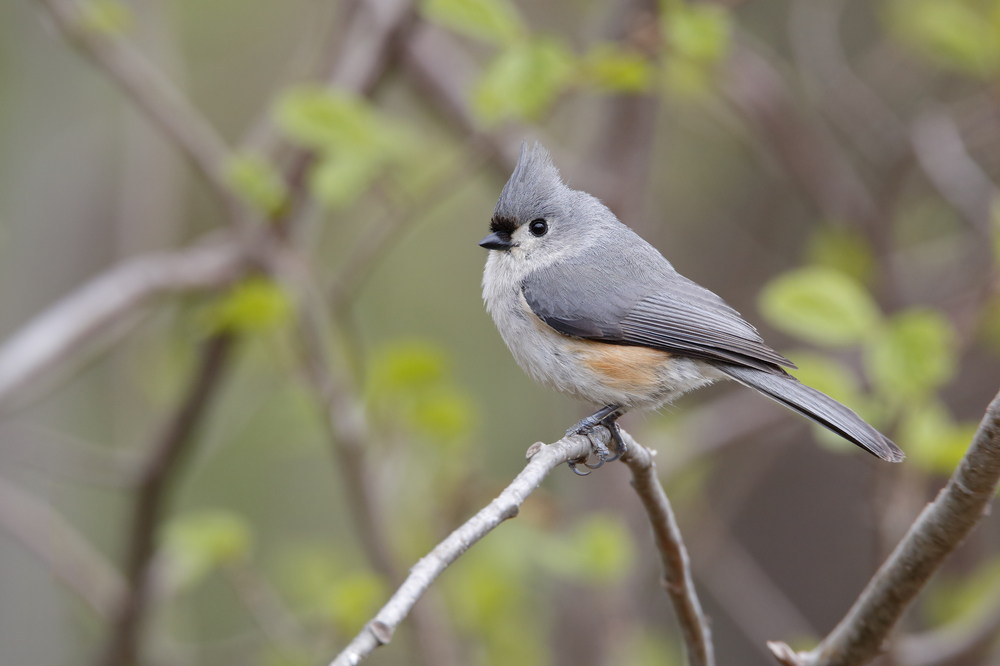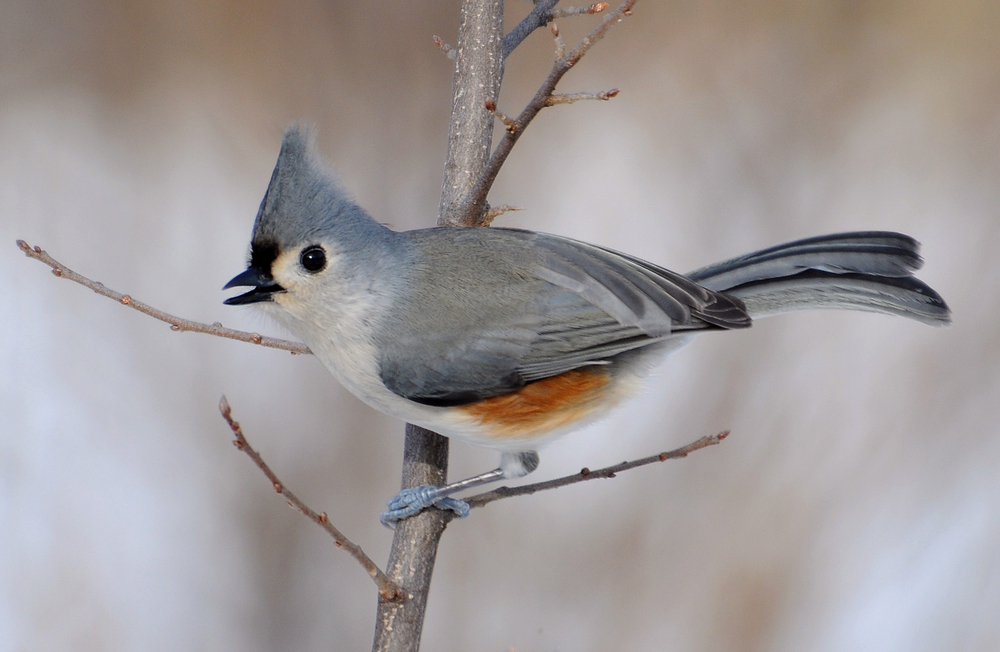In North America, there are in fact 5 species of titmouse commonly seen at backyard bird feeders: the Tufted Titmouse, Oak Titmouse, Black-crested Titmouse, Bridled Titmouse, and Juniper Titmouse. Titmice belong to the family Paridae. This family of songbirds includes tits, chickadees, and titmice.
Some species overlap while others have distinctive ranges. Whichever titmouse species is common in your area, these small birds are always a delight. Titmouse species have an average wingspan of 7-10 inches. But it isn’t their tiny stature that catches the eye of bird watchers.
Titmice have a crest of feathers atop their head. Coupled with their round bodies, black eyes, and serious expression, the overall effect gives the impression that this little songbird has a lot of sass. Titmice are bold for their size, but they’re no more aggressive than most other songbirds.
The common name “titmouse” comes from Old English. The words “tit” and “mase” combined, meaning “small bird.” Eventually, the common name evolved to become “titmouse” or “titmice” in the case of multiple birds. We’ll cover the different types of titmice in North America and share some exciting facts and behaviors of these fun little birds.
What does the tufted titmouse look like?
The tufted titmouse gets its unique name from the gray feather crest that makes a cone shape atop its head. These little gray birds have black eyes and a black beak. They also have a black forehead and black tips on gray wings. Orange shading on the flanks contrasts strikingly against their white to grayish undersides.
The tufted titmouse (Baeolophus bicolor) is probably the most well-known of the five species. Their year-round home range goes from eastern Texas and Oklahoma, spreading northeast into New York and Ontario, Canada. They favor deciduous forests and urban forests with tall, well-established trees.
They have a scratchy, fussy call that sounds a lot like a chickadee. But the sound of the tufted titmouse is most known for is its whistle. The tufted titmouse whistle sounds like the neener-neener-neener of children on the playground. Some even say it sounds like the tufted titmouse is calling “peter peter peter.”
What are the physical characteristics of the black-crested titmouse?
The black-crested titmouse is a little gray songbird that looks very similar to the tufted titmouse. The most significant difference between the two is the black-crested titmouse’s black forehead extends the height of its entire crest. This black mark creates a bold black crest. They have gray upperparts and white to gray undersides with orange flanks.
The black-crested titmouse (Baeolophus atricristatus) range is confined to parts of Mexico, Texas, and a few counties in southern Oklahoma. They are non-migratory birds that live in the same areas year-round. Sometimes called the Mexican titmouse, this species was once lumped in with the tufted titmice.
Since 2002, these two birds have been considered separate species. This is partly due to the large black patch on the black-crested titmouse’s head. The other deciding factor was the difference between their bird songs. Black-crested titmice are known for their sweet whistle that sounds like “peer peer peer” and their “chick-a-dee” call.

What are the key features of the bridled titmouse?
The bridled titmouse is gray all over, with an eye-catching head pattern. Swirling black stripes highlight the edges of the crest, eyes, and cheek on this striking bird. A triangle-shaped black patch covers the throat. The undersides are lighter gray to white in color.
The bridled titmouse (Baeolophus wollweberi) can be found in parts of Mexico, Arizona, and the southwesterly edge of New Mexico. They stay in their home range year-round, often flocking with chickadees, nuthatches, and warblers. Nimble and bold, they are often seen hanging upside down while foraging for insects from thin branches.
What kind of habitat does the juniper titmouse like?
As its name suggests, the juniper titmouse prefers open woodland spaces with abundant juniper trees. They live year-round in and around the Great Basin region of the United States. This area includes Colorado, New Mexico, and Arizona, where the juniper titmouse population is most dense. Parts of California, Nevada, Idaho, Texas, and Mexico are included in their extended range, but their numbers are far scarcer.
Juniper titmice (Baeolophus ridgwayi) are gray all over with an impressive steel gray crest. Their wings have black edges. Males and females of this species do look identical. Like other woodland dwelling titmice, they are known to hang precariously from thin branches in search of insects. Their song is scratchy, with rapid-fire thrilling notes that sound very similar to video game sound effects.

Where does the oak titmouse live?
The oak titmouse lives in forests comprised primarily of oak trees and oak pines. They have a small range in and around the San Joaquin Valley. The oak titmouse’s range extends from Baja California, Mexico, through most of California and southern Oregon. They stay near their home range year-round.
Oak titmice (Baeolophus inornatus) are gray all over and look identical to the juniper titmouse. The two combined were considered the plain titmouse. In 1996, they were split into separate species due to genetics, habitat preferences, and the sound of their song. The oak titmouse call sounds like “peter peter peter,” just like the call of the tufted titmouse.

Are there similar species that look like a titmouse?
Many small North American birds are confused for titmice. Other Paridae birds, like chickadees and even nuthatches, look similar enough to the titmouse as these little songbirds fly by.
Black-capped chickadees and Carolina chickadees are often confused for titmice. Upon closer inspection, neither of these chickadees has a crest, which is a prominent feature of titmice.
Nuthatches are also confused with titmice. This songbird from the family Sittidae likes to travel in small flocks with titmice and chickadees. Sightings in flight are difficult enough, but with the three similar species moving in small flocks together, it’s easy to mistake them for one another.
Where can you find a titmouse nest?
You can find titmouse nests in natural cavities. They are secondary cavity nesters, making their nests in woodpecker holes. Titmice will also build their nest cavity in nest boxes and birdhouses. Titmice use natural materials for nests, but they have also been known to pluck hair from live animals like woodchucks and even raccoons to line their nests!
Offering birdhouses that mimic woodpecker holes is the best way to attract titmice to your backyard. Hanging nest boxes for titmice can help them raise their single brood successfully. Titmice only lay 3-9 eggs a year, so it’s important not to disturb them. Leave nest boxes untouched until the fall to accommodate their breeding cycle.
- Incubation period-12-14 days
- Nestling period-15-16 days
- Fledge at 17 days old
- Young titmice can raise their own babies by the next breeding season.
Fun fact: In the warmer regions, titmice can have two broods in a single breeding season. When this happens, the older nestlings will help care for the younger hatchlings.
What kinds of food will attract titmice to backyard bird feeders?
Like many songbirds, titmice are omnivores. They will actually eat a variety of seeds and insects. Titmice like a lot of variety in their diet. Providing several options from their favorites will help attract titmice to your backyard bird feeder:
- Acorns
- Sunflower seeds
- Suet
- Caterpillars
- Berries
- Mealworms
Titmice will even eat spiders and wasps around your home! They also like snails, but it’s best not to feed them to any songbirds due to parasite risk. Planting native plants is one way to attract plenty of feeder insects for your titmouse flock, but you can also buy live feeder insects from pet stores.
The titmouse is a delightful small bird that is an excellent addition to your backyard flock. By providing their favorite foods, nest boxes, and a birdbath, you can attract titmice to your backyard bird feeder in no time. Whichever of the 5 species of titmouse lives in your range, you’re sure to enjoy this boisterous little bird for years to come.

